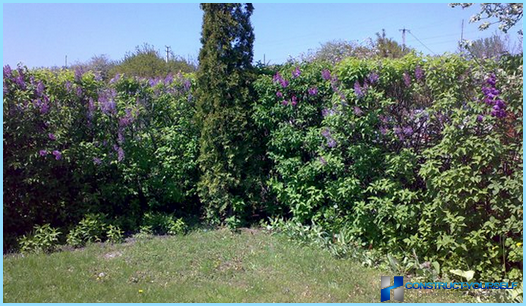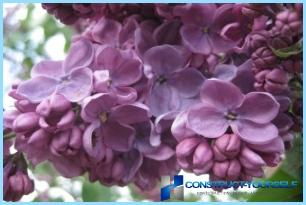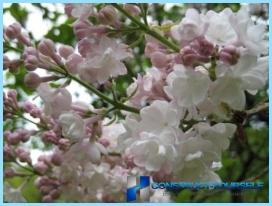The contents

A hedge is a good way to mark the territory of Your land and to provide within it a pleasant climate, thanks to the reliable protection from wind and dust, as well as some noise insulation. A natural fence of shrubs will give Your possessions visual appeal and completeness. In order to hedge effectively cope with its functions, it is important to choose plants to create it. Lilac is perfect for this role, since it is rather undemanding shrubs of our climate bands, a fast-growing and easily trimmed. If in addition, You like the smell of these flowers and their appearance, the hedge of lilac – exactly what You need.

How to choose the right sort of lilac ↑
Favorite type of lilac that is used in ornamental horticulture, is the common lilac. She has good endurance, easily tolerate drought, are not afraid of pests and diseases. Grows well outdoors in the southern, middle and Northern belt of Russia. Is a spreading shrub, a height of 3-6 meters. Lilac has about 500 varieties.

The smell of lilacs is strong enough, therefore, for the fence choose the cultivar (variety) that will appeal to Your sense of smell. Plays an important role and aesthetic pleasure from the appearance and color of inflorescences. Lilacs can be white, purple, violet, blue, blue and pink colors.
You might like the next varieties:
- Cosmos (Kosmos);
- Beauty Of Moscow (Krasawica Moskwy);
- Firmament (Firmament).
Grade «Space» great for high hedges, as these shrubs pryaralye, quite tall, with long shoots. Inflorescence large, purple with a blue tinge, fragrant. The average period of flowering, blooming profusely. Has good resistance to heavy rains and winds, ruggedness.

Beauty Of Moscow» – blooms pinkish-white double flowers, quite long (about 20 days). Shrub height up to 4 meters. The variety is resistant to frost and droughts. Blooms only in the sun. Does not tolerate heavy, wet soils too.
Varieties «Firmament» or «The sky» get a very nice hedge with pale blue flowers. The plant loves the sun. Frost-resistant, does not impose high requirements on the soil, suitable for urban area.
How to plant a hedge with their hands ↑
Yourself to plant a beautiful hedge of lilacs is quite easy, you only need to follow some sequence of actions.
- To calculate the required number of shrubs. To do this, the expected length of the fence should be divided into the distance between plants (1.5 m or 3 m).
- To purchase seedlings. It is best to buy 2 or 3 year old shrubs, because they are better preserved due to the sufficiently developed at this age the roots.
- Prepare shrubs. Long roots do shorter, cut the branches a couple of kidneys, making sure that at least one kidney were alive on each stalk. Branches should get a length of about 15 cm.
- To select the location of the fence. To get a lush flowering hedge, it must be planted from the North-West, North or North-East, since lilac «deploys» its bloom towards the Sun.
- To prepare the soil. For each shrub you should dig a hole depth of 0.5 m. If the soil is poor, the holes need to do more with depth of 1 m. the Top of barren soil layer is better to be removed and the soil to fertilize with a mixture of compost (15-20 kg), wood ash (200-300 g) and superphosphate (20-30 g). In a heavy clay soil you may need to add drainage to avoid water stagnation. You can also check the soil pH. In the case of high acidity add to it chalk, limestone or dolomite.
- Two weeks after the procedure, preparing the soil to plant a lilac. To obtain a thick and beautiful hedge, shrubs should be placed in a checkerboard pattern. Typically, the distance between plants is kept equal to 1.5 m, but for varieties with a spreading crown, it can be increased up to 3 m.
- Water the lilacs. After complete absorption of water to perform a mulch (cover) the hole with humus or peat. This can further fertilize the soil and protect it from drying out. Pour the resulting fence need at least 1 time a week. When it will expand to the desired extent, You can water it just once a month 1.
How to care ↑
It is known that with good care, a lilac can please others its flowering over a hundred years. For example, in 1750 in England was planted lilac bushes, who lived 180 years.
In order to hedge has retained its appeal, it should be cut 1 time per year, cutting curves, and weak branches. Cut lilac shears can be performed only after the end of flowering, otherwise it will adversely affect the health of the plant.
If the holes at planting was fertilized, then the next time feeding nutrition mixtures should be run in 2-3 years. After two years of fertilizer applied urea or ammonium nitrate, three years later – organic fertilizer.
Lilac in winter a young (age 2-3 years) need to cover, sprinkle the roots with peat or dry leaves. The thickness of the layer should be from 10 cm This procedure will prevent freezing of plant roots. Adult lilac frost and protecting the roots do not need.









